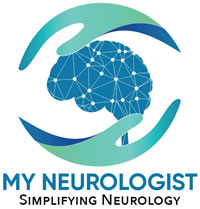Normal pressure hydrocephalus or NPH is a brain disorder. The term hydrocephalus means extra fluid in brain cavities. All human brains have a central cavity called ventricle, filled with a fluid called cerebrospinal fluid or CSF. The cavity in the brain is divided into different parts, or named in this manner, based upon its location. All parts of the cavity, or ventricles, are connected to each other. The big ones are in the cerebral cortex called lateral ventricles. They drain into a single cavity called 3rd ventricle in the middle of the brain, which is connected to the 4th ventricle in the brainstem.
In young age and in a normal brain these cavities look relatively small. With aging, as brain shrinks, these cavities look bigger. But sometimes they look abnormally big, out of proportion to the amount of brain shrinkage. This is when it is called Normal Pressure Hydrocephalus or NPH. This is in contrast to enlargement of ventricles due to a blockage within the ventricles (e.g., by a tumor), when ventricles get large due to high pressure. In NPH, there is no visible blockage and the pressure in the ventricles stays within normal limits.
What are the symptoms of NPH?
NPH causes three types of symptoms or problems:
a. Gait disorder: Patients walk in a wide-based gait with difficulty in lifting their feet. It is like their feet are magnetically attached to the ground, so is the name given to it, magnetic gait. Patients may also look like having some symptoms of Parkinson disease.
b. Loss of bladder control: Patients develop urgency and frequency of urination. In untreated cases and in later stages, it may lead to incontinence.
c. Dementia: It may also cause mild to moderate dementia.
What causes NPH?
Exact cause is unknown but it seems to be a problem with absorption of spinal fluid, resulting in too much fluid in the ventricles, which increases their size. Large ventricles somehow put pressure on the surrounding brain affecting its function, and also causing degeneration or loss of brain cells.
Who is at risk for NPH?
Other than aging, no particular risk is identified. NPH typically is middle to old-age disease.
How is NPH diagnosed?
With its typical symptoms, a brain scan is ordered. Both CT and MRI scan may help to make the diagnosis, but MRI is better to provide further detail about any other pathology that may also be present.
If CT or MRI of brain reveals enlarged brain ventricles or cavities, out of proportion to the amount of brain shrinkage, the diagnosis of NPH is made. Further testing is done to figure out if patient may benefit from the treatment or not.
What treatment options are there for NPH?
Without treatment, NPH usually progresses causing more problems, and may ultimately result in a patient not able to walk, incontinent, and significantly demented. On the other hand, with treatment all of these symptoms can improve, or significantly slow down.
There is no medicine to treat NPH. The available treatment at this time is surgical by inserting a thin tube, a shunt, in brain cavities with its other end in the patient’s belly. The shunt continuously drains the spinal fluid and patient feels better.
Before the shunting procedure is undertaken, it is important to know if a patient may respond to this treatment or not. This is achieved through a lumbar puncture (a spinal tap). Many times, in addition to removing some fluid, a radioactive dye is injected in the spinal fluid and its flow is studied for next 2-3 days. This part of the test, a cisternogram, helps to determine if spinal fluid is being properly absorbed. If patient’s symptoms of walking and bladder control improve after removing some fluid, though temporarily, and the cisternogram suggests problem with absorption of spinal fluid, patient is referred to a neurosurgeon for shunt placement.
What may be the complications of NPH shunting procedure?
Other than risks associated with any other surgery, a surgery in and around brain may cause intracranial bleeding. Its risk is about 5-10%. The shunt may get blocked or infected, and sometimes may have to be replaced. My long experience of dealing with patients with NPH, especially the ones treated with shunting, is that it is a reasonably safe and effective treatment.
Where can I get more information about Normal Pressure Hydrocephalus (NPH)?
American Academy of Neurology
American Neurosurgery Association


Leave a Reply
Your email is safe with us.
You must be logged in to post a comment.